An interview with Doug Gunzelmann.
Like all commercial roads through rainforests, the 5,300 kilometer long Rodovia Transamazonica (in English, the Trans-Amazonia), brought two things: people and environmental destruction. Opening once-remote areas of the Amazon to both legal and illegal development, farmers, loggers, and miners cut swathes into the forest now easily visible from satellite. But the road has also brought little prosperity: many who live there are far from infrastructure and eek out an impoverished existence in a harsh lonely wilderness. This is not a place even the most adventurous travelers go, yet Doug Gunzelmann not only traveled the entirety of the Transamazonica in 2009, he cycled it. A self-described adventurer, Gunzelmann chose to bike the Transamazonica as a way to test his endurance on a road which only a few before have completed. But Gunzelmann wasn’t just out for adrenaline-rushes, he was also deeply interested in the environmental issues related to the Transamazonica. What he found was a story without villains, but only humans—and the Amazon itself—trying to survive in a complex, confusing world.
“These days, it’s very difficult to be the first or fastest in any endeavor, but this gave me the opportunity to be amongst a few who have completed the route on bike,” Gunzelmann told mongabay.com in a recent interview, adding that “the difficulty of this trip intrigued me. There is no real reward on a day to day basis other than to push forward. Maybe that’s why so few people have bothered cycling this road. I wanted to face a punishing journey.”
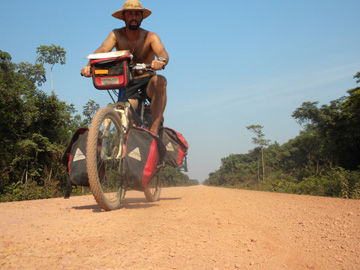 Gunzelmann biking the Transamazonica. Photo courtesy of Doug Gunzelmann. |
Punishing it was: Gunzelmann faced thousands of miles of roadway through exhaustingly hot forests, endless hills, and then had to cross over the Andes to reach his final destination in Lima, Peru. On his journey, Gunzelmann says that evidence of environmental destruction was everywhere.
“Everyday I would hear the buzz of chainsaws. Charred lots skirted the road the entire length and nearly the entire length of the TransAm is abutted by fazenda, or cattle ranch, 100-200 meters on either side before the tall green jungle is visible. I met miners along the road and saw huge shanty towns and strip mines in Peru. […] It is openly illegal, but there is no one there to enforce these laws.”
There are three major environmental issues in the region according to Gunzelmann: deforestation, massive hydrological projects including the infamous Belo Monte dam, and the roadway itself which has opened the region to often unregulated development.
“Roads will bring destruction, no question about it, but how does one meet Brazil’s right to compete and keep the Amazon from being mowed down in the process?”
This became the question Gunzelmann consistently faced during his travels. He realized quickly that the people directly participating in environmental destruction were not ‘villains’ as they are sometimes categorized, but simply trying to survive.
“The people I met and witnessed poaching and deforesting were good people and very kind to me, at times saving me from potential disaster. Some were completely selfless, giving the shirt off their back when they had so little to give. They were providing for themselves and their families immediate needs. Their alternative options were generally limited,” Gunzelmann said. “These people should be no more vilified than the average person from the developed world whose environmental impact is likely to be much more severe over time.”
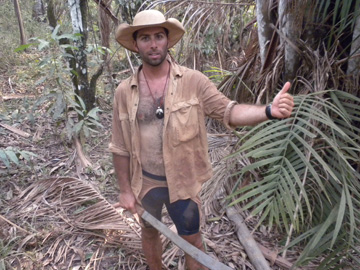 . Making a camp in the jungle. Photo courtesy of Doug Gunzelmann. |
Yet the problem remains: how does Brazil lift its population out of poverty while at the same time safeguarding the forest, which provides intrinsic benefits from carbon sequestration, biodiversity, and clean water?
“I now realize how tightly woven we all are as a global community. We can’t ask Brazil to stop destroying the jungle without asking ourselves to stop consuming and creating the demand for those products,” Gunzelmann says. “Brazil is competing in the global market place to create wealth and prosperity for its people. The US has done the same, becoming an economic powerhouse, while wreaking havoc world wide in the process. People should realize the quality of life they enjoy may be a direct result of this attitude toward the environment. If you want a mahogany bedroom set then perhaps realize a road will be cut through the jungle to fell a single tree to meet your demand. Who’s more to blame, the lumber company, the peasant who cut down the tree, or you?”
While there is no simple or easy answer, Gunzelmann says that looking to the past may help bring about a solution.
“Researchers have learned the Amazon Basin supported a huge population in ancient times without destroying the forest. I would think that the possibilities are limited only by ones imagination. The issue is time and effort.”
Gunzelmann says that his trip across South America earned him the “right to rest”—at least for a little while. He’s looking at options for his next cycling adventure (hint: “it’s more remote, in worse condition, and on the opposite extreme of temperature” as the Transamazonica).
In an October interview Doug Gunzelmnan talked with mongabay.com about his adventures on the Transamazonica (including a run-in with a jaguar), his experiences with loggers and farmers, the challenge for Brazil to balance development while protecting the rainforest, and why the Amazon’s survival depends on western consumption patterns.
AN INTERVIEW WITH DOUG GUNZELMANN
Mongabay: What’s your background?
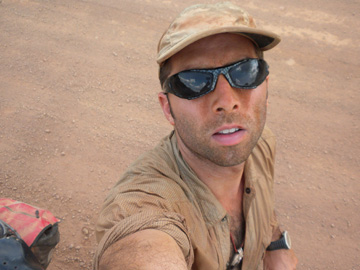 . Gunzelmann covered in dust after leaving Pacaja. Photo courtesy of Doug Gunzelmann. |
Doug Gunzelmann: I’m the middle brother of three from upstate New York. I went to Notre Dame on a track scholarship (ran the 800m) and studied biology. Since my freshman year in college I have been traveling around the world whenever my wallet allows me to. Some off the cuff adventures include bullfights in Nicaragua, Muay Thai in Bangkok, bribing armed guards in Guatemala, and rallying my rental car along the race course at Monte Carlo.
Mongabay: What inspired you to bike the entirety of the Transamazonica?
Doug Gunzelmann: First off, I left on my 29th birthday. The approach of a man’s 30th year is a powerful motivator to break out of the daily grind. Second, it had been cycled only a few times in its history. These days, it’s very difficult to be the first or fastest in any endeavor, but this gave me the opportunity to be amongst a few who have completed the route on bike. Third, the difficulty of this trip intrigued me. There is no real reward on a day to day basis other than to push forward. Maybe that’s why so few people have bothered cycling this road. I wanted to face a punishing journey.
Mongabay: What is the significance of this road?
Doug Gunzelmann: The Transamazonica, or BR-230, bisects the jungle interior for thousands of miles giving land access to otherwise inaccessible jungle. This road has been utilized by settlers, loggers, and miners. Recently, its importance has come into the lime light with the building of the Xingu dam which will provide electricity for Brazilians in every direction. The project is huge and will require paving of long stretches of the TransAm. This has been a major issue in Brazilian media lately, especially as a campaign topic amongst politicians seeking election.
ADVENTURES
Mongabay: Even adventurous people would probably never consider doing what you did, what kept you going?
Doug Gunzelmann: Many things kept me motivated on any given day of the brutal ride. Receiving encouraging emails and comments on my website was something that kept me in touch with my friends and family back home. There was a lot of time to think while pedaling up to 12 hours per day and thinking of those words of encouragement were helpful. Next, was the disappointed I’d feel for failing. I wanted to make it a “respectable” distance across the jungle before being forced to stop. Luckily, time and circumstance led me to the opposite coast despite a million potential pitfalls. Finally, people can become accustomed to almost anything. After 5 weeks or so I felt strong and confident which meant high moral which in turn meant steady progress. A positive attitude is essential for forward movement.
Mongabay: What was the best moment of your journey? What was the worst?
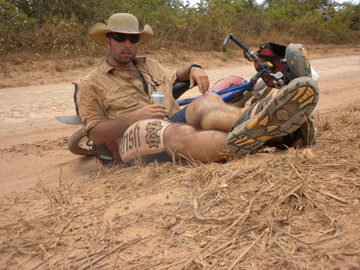 Gunzelmann taking a beer break. Photo courtesy of Doug Gunzelmann. |
Doug Gunzelmann: The best moment undoubtedly was my arrival in Humaita. That was the end of the roughest part of the TransAm (and far enough before the Andes for me to worry about them yet). I got drunk, ate a lot of burgers and ice-cream, and did a little fishing. The worst was being sick in Jacareacanga. I had been riding myself into the ground with inadequate nutrition and had never felt weaker in my life. The nearest town of any size was 350 miles back through untouched jungle to the east, or 500 miles of abandoned farmland to the west. I truly felt isolated and hopeless.
Mongabay: Will you tell us about your encounter with a jaguar?
Doug Gunzelmann: I was at the end of an 11 hour day of pedaling and about 100 miles into a jungle reserve. I set up camp in the jungle and was standing in the road with my SAT phone as it began to rain. I could hear heavy thunder in the distance and dusk was 20-30 minutes away. There was a deep grunting noise that I assumed was from a howler monkey. They make a sort of blunt roar at dusk and dawn. The sound persisted and seemed close which I looked uphill on the narrow roadway and saw what looked like a baby cow, or calf. That would have been impossible of course and I quickly realized the animal looking at me broadside was a jaguar.
Mongabay: You had never traveled alone before this. In a foreign land, in the middle of no-where, how did you combat loneliness?
Doug Gunzelmann: I was most lonely the first few days and on some of the holidays. When your surroundings are unknown, and your future is unknown, you begin to lose yourself. It’s an unsettling feeling indeed. However, the job of moving forward everyday began to force out everything else. After a few weeks I never felt very lonely again. That’s something people probably won’t know about themselves until they are truly removed. My ability to function alone was news to me!
CONSERVATION AND SOCIAL ISSUES
Mongabay: What are the environmental impacts of this largely failed road project, the Transamazonica, on the Amazon rainforest?
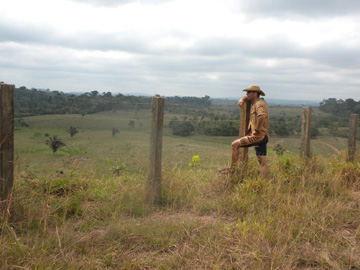 Gunzelmann near Uruará. Cattle ranching (pictured here) and soy farming extend along the Transamazonica. Photo courtesy of Doug Gunzelmann. |
Doug Gunzelmann: During my trip I saw three major issues concerning the Amazon, its resources, and the people living there (of course there are more). First is the creation of dams for hydroelectric power. The Tucurui dam is one of the largest in the Amazon Basin and will be joined by a dam in the Xingu river area around Altamira called Belo Monte. The dam will of course result in flooded jungle which will displace the people and animals that live along these waterways as well as disrupt the livelihood of those living down stream of the dam. I witnessed protests for water rights and against the construction of these dams in Belem and Altamira.
Next is the popular deforestation issue which is easily observed on nearly all of the Transamazonica. I spent nights with the men and woman responsible for some of this destruction as well as time and meals with people who now depend on the cleared land for a living. It’s a complicated problem for me to come to terms with now. There needs to be a resolution that preserves the jungle yet allows these people to at least maintain their livelihoods and better yet to prosper. Brazilians have every right to work towards a higher quality of life and are competing on a global market to accomplish this, as are Americans.
Finally, the roadways themselves are a major issue in this part of the world. Roadways, like the Transamazonica or the Trans-Oceanic highway, offer access to these remote areas and the potential for exploitation of the jungle and people. However, the people I came to depend on for my own safety and well being also depend on these roads for transportation of their goods and themselves. These roads allow Brazil, Peru, and other countries of South America to move their goods to ocean ports to sell on the world market. For instance, parts of the Transamazonica between Santarem and Cuiaba have been widened and paved since I rode them a few months ago, to transport truck loads of soybeans. Roads will bring destruction, no question about it, but how does one meet Brazil’s right to compete and keep the Amazon from being mowed down in the process?
Mongabay: How active is cattle ranching, slash and burn farming, and mining along the road?
Doug Gunzelmann: All of those activities are very rampant. Everyday I would hear the buzz of chainsaws. Charred lots skirted the road the entire length and nearly the entire length of the TransAm is abutted by fazenda, or cattle ranch, 100-200 meters on either side before the tall green jungle is visible. I met miners along the road and saw huge shanty towns and strip mines in Peru. I was giving a few pieces of white Brazilian Topaz by a drunk miner in Humaita. The Trans-Oceanic road in Peru is especially a hotbed for illegal mining activities. It is openly illegal, but there is no one there to enforce these laws.
Mongabay: You spent some time with poachers and loggers, who are often vilified by environmentalists. What is your view?
Doug Gunzelmann: Few things are black and white, and of course these issue are no exception. The people I met and witnessed poaching and deforesting were good people and very kind to me, at times saving me from potential disaster. Some were completely selfless, giving the shirt off their back when they had so little to give. They were providing for themselves and their families immediate needs. Their alternative options were generally limited.
More or less these activities have been culturally ingrained. These people should be no more vilified than the average person from the developed world whose environmental impact is likely to be much more severe over time.
Mongabay: Poverty is one of the biggest issues in the Amazon. Do you see any way to lift people up without destroying the forest?
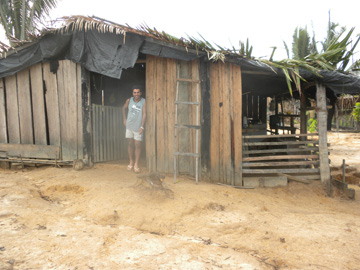 Resu, a pig farmer, who Gunzelmann stayed with on the road. Photo courtesy of Doug Gunzelmann. |
Doug Gunzelmann: There are many ways to sustainably use the forest to support its inhabitants. Researches have learned the Amazon Basin supported a huge population in ancient times without destroying the forest. I would think that the possibilities are limited only by ones imagination. The issue is time and effort. Often the quickest and most profitable ways to turn a buck are the destructive ones.
Mongabay: What was your impression of the lives of indigenous communities in the area?
Doug Gunzelmann: Indigenous communities are either being marginalized by “progress” or have already been marginalized or absorbed by development. The tribes being subsidized by FUNAI that I witnessed in Jacareacanga and Itaituba were largely listless and had alcohol abuse issues. They functioned outside the Brazilian culture in these towns even while occupying the same space. The day-to-day life I saw reminded me greatly of the conditions and issues found on Indian reservations here in the United States.
Mongabay: After seeing the forest loss face-to-face and meeting the people who build their lives along the road, have your views of environmental issues changed?
Doug Gunzelmann: I now realize how tightly woven we all are as a global community. We can’t ask Brazil to stop destroying the jungle without asking ourselves to stop consuming and creating the demand for those products. Brazil is competing in the global market place to create wealth and prosperity for its people. The US has done the same, becoming an economic powerhouse, while wreaking havoc world wide in the process. People should realize the quality of life they enjoy may be a direct result of this attitude toward the environment. If you want a mahogany bedroom set then perhaps realize a road will be cut through the jungle to fell a single tree to meet your demand. Who’s more to blame, the lumber company, the peasant who cut down the tree, or you? I don’t want to be preachy, we are all more connected than we might realize is all.
Mongabay: What do you say to people in the US who wonder how they can help or what changes they should make in their own lives?
Doug Gunzelmann: This is very simple, consume less and know how your purchases impact the world beyond you. For example if you eat beef, realize where the meat might come from. If you say you’re a vegetarian, realize where your soy might come from. Bottom line is to be mindful of your role in the greater world picture.
Mongabay: How much hope do you have for the Amazon?
Doug Gunzelmann: Hope for the Amazon is directly linked with my faith in man to do what is right. Perhaps there is a grim outlook, especially if we base future behavior on historical trends.
FUTURE
Mongabay: How did the trip change you as a person?
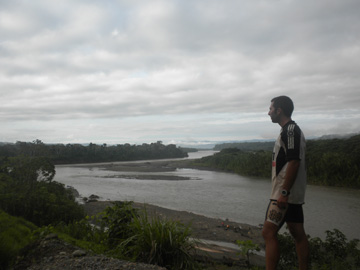 Gunzelmann at the foothills of the Andes in Peru. Below him, along the river, is a gold mining camp. Photo courtesy of Doug Gunzelmann. |
Doug Gunzelmann: I’m a restless person. The expedition pushed my body, my mind, and my emotional endurance to the edge. I took this trip on as a sort of pilgrimage.
Colombian presidential candidate Ingrid Betancourt quoted perfectly after her captivity in the Amazon jungle by members of the FARC paramilitary: “many times in the Bible—it says that when you cross the valley of tears and you arrive to the oasis, the reward of God is not success, it’s not money, it’s not admiration or fame, it’s not power—his reward is rest.”
That’s what I gained in some part of my mind, the right to rest.
Mongabay: If someone wanted to follow in your bike tracks, what piece of advice would you give?
Doug Gunzelmann:
- Pack light
- Learn to love dust (for breakfast, lunch, and dinner)
- The rolling hills will eventually end, it just takes 1500 miles
- Raise your fist and bark back at dogs (get a rabies vaccine before starting the trip)
- Traversing the Andes takes lungs and patience, but coca leaves help
Mongabay: What’s your next adventure?
Doug Gunzelmann: I’ve been looking at The Road of Bones through Siberia. Compared to the Transamazonica it’s more remote, in worse condition, and on the opposite extreme of temperature. Perhaps the most difficult road to cycle in the world!
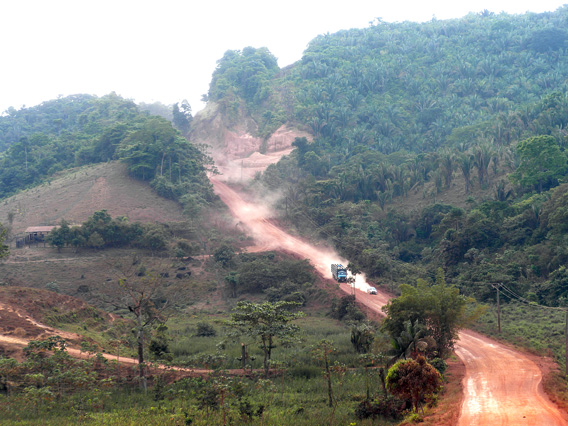
Hills to Pacaja. Photo courtesy of Doug Gunzelmann.
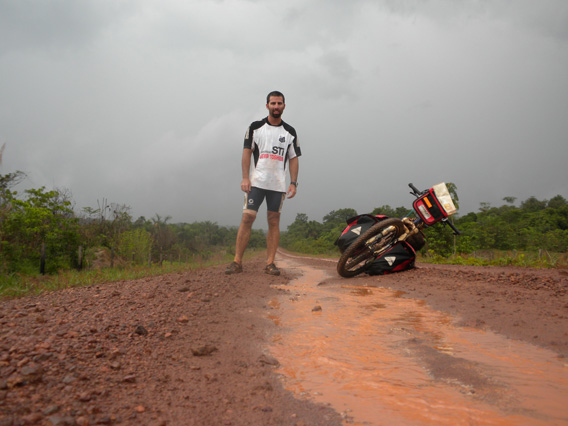
Pit stop after downpour. Photo courtesy of Doug Gunzelmann.
Related articles
Conserving nature with economics
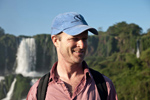
(09/29/2010) While many factors come into consideration when the fate of forests are being determined, economics often play a key role in land use decisions. When the perceived value of forest land is higher as cattle pasture, cropland, or plantation, then trees fall. But what happens when economic assumptions underlying these decisions are wrong? Forests, including the services they provide and the biodiversity they shelter, are lost in vain, much to the detriment of society and the planet. Working to avoid these costly outcomes is the Conservation Strategy Fund (CSF), a California-based nonprofit that trains conservationists to use economics and strategic thinking as assets to conserve natural ecosystems in countries around the globe. CSF runs training programs that help emerging conservation leaders build and strengthen parks, influence policies, and avert damage from infrastructure projects.
Camping in the Okavango Delta in Botswana

(08/19/2009) The first animal we saw in the Okavango was unmistakable. Although far away, we could easily make it out with its telltale trunk: an African elephant—the world’s largest land animal—was striding peaceably through the delta’s calm waters. We watched, entranced, from the mokoro, a small boat powered and steered by a local wielding a long pole to push the craft along.
Advice for your first visit to the rainforest
(03/03/2008) Harry S. Pariser has been writing travel guides and articles for many years now. His most recent guide is Explore Costa Rica which has extensive information about the nation and its rainforests.
Climbing Africa’s second highest mountain
(11/05/2007) Mount Kenya, Africa’s second highest mountain, is said to be one of the continent’s most beautiful hikes. Located less than three hours’ drive from Nairobi, Mount Kenya is accessible and makes for a great add-on for fit travelers looking to do more than the standard safari in Kenya.
Hiking through Myanmar, the country better known as Burma
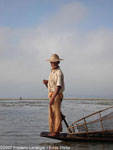
(02/18/2007) The recent history of Myanmar is rather grim. After gaining independence from the British in 1948, the country suffered a series of military takeovers, and has basically been under the dictatorship of a military junta for the past 50 years. At several points during this time, the people have taken to the streets to peacefully protest the military regime. The last major fight for democracy occurred in 1988, and climaxed with the first democratically held election since independence. The National League for Democracy (NLD), spearheaded by the charismatic Aung San Suu Kyi, won by an overwhelming 84% of the vote. Sadly, regardless of their promises, the military junta had no intention of relinquishing their power, and imprisoned the major leaders of the NLD.
Jungle trekking in Malaysia’s Taman Negara
(03/21/2006) Taman Negara is Malaysia’s largest and best-known national park. Spanning 4343 square kilometers, the protected forest area is home to some of southeast Asia’apos;apos;s rarest creatures including tigers, the Malaysian tapir, forest elephants, and the Sumatran rhino. Scientists believe that these rainforests may be the oldest on Earth. Untouched by glaciers during recent ice ages, Taman Negara’apos;apos;s forests have remained largely the same for some 130 million years. This stability produces some of the highest levels of biodiversity on Earth: more than 350 species of birds, 14000 species of plants, and 210 species of mammals can be found in Taman Negara.
Down a river of blood into a remote canyon in Madagascar: Exploring the Manambolo River
(04/24/2005) Madagascar has been called the great red island and from space, astronauts have remarked the island looks like it is bleeding to death. Severe environmental degradation means Madagascar loses more topsoil per hectare than any country in the world. Being one of the poorest nations on Earth, the people of Madagascar can ill afford this loss. In 2004 I set off to see one of these rivers that is carrying away the lifeblood of the Malagasy; the Manambolo of Western Madagascar.